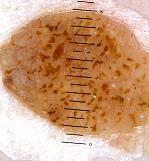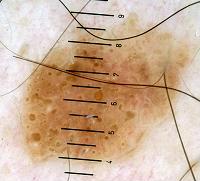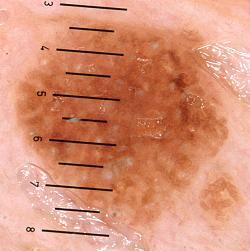- Kératose séborrhéique=KS
 Aspect cérébriforme et kystes cornés (milia-like cysts)
Aspect cérébriforme et kystes cornés (milia-like cysts)
-Les vaisseaux en épingle à cheveux sont des anneaux capillaires alongés qui se dévéloppent à la périphérie des tumeurs kératinisantes {Kreusch, 1996}. Typiquement, plusieurs vaisseaux s’agglomèrent et sont entourés par un halo blanc, prenant l’aspect d’un grappe de raisons {Braun, 2002}. Ceci est plus fréquent dans les KS irritées {Braun, 2002; Braun, 2002} {Stolz, 2002}. Ce signe n’est pas spécifique, car le mélanome malin peut aussi montrer des vaisseaux en épingle à cheveux.
-L’aspect en pseudoréseau et les emprintes digitales (fingerprinting) : ça ne ressemble pas toujours au réseau pigmenté des lésions mélanocytaires bénignes, et consistent de lignes entrecroisées hyperpigmentées imbriquées avec des lignes hypopigmentées {Menzies, 1996; Argenziano, 1998; Argenziano, 2000 ; Soyer, 2000; Kenet, 1993; Kreusch, 1991} {Stolz, 2002; Yadav, 1993}. Les lignes des pseudoréseaux sont beaucoup plus larges que celles d’un réseau typique et peuvent se terminer de manière abrupte en périphérie {Braun, 2002}. {Braun, 2002}. Les lignes correspondent à une hyperplasie épidermique modérée, une hyperkératose et une augmentation de la mélanine dans les kératinocytes {Schiffner, 2000}. Les « trous », qui sont beaucoup plus larges que dans un réseau mélanocytaire traditionnel, correspondent souvent aux fissures et ouvertures en pseudo-comédons (psudoglobes cornés). ou encore à des endroits remplis de kératine (bouchons cornés), mais pass toujours aux pointes des papilles dermiques {Schiffner, 2000}.
– Les Bords « rongés par les mites » ou émiettés (Moth-Eaten) {Schiffner, 2000} sont des brodures entamées et irrégulières qui se retrouvent dans les KS à un stade de développement précoce et les lentigos solaires.
– « Wobble pattern » {Braun, 2002}. En examinant une lésion cutanée, il a été montré que les KS {Braun, 2000} adhèrent au dermatoscope lorsque celui-ci est légèrement bougé horizontalement parallèlement à la surface cutanée. De plus, les KS ont une consistance si solide que son apparence lors de l’examen au dermatoscope ne change pas lorsque celle-ci est bougée.
– Démarcation nette {Braun, 2002} dans 90% des cas dans une étude de 204 KS pigmentées.
 Une KS bien délimités, avec un bordure « rongée par les mites », des kystes cornés et des ouvertures en pseudo-comédons.
Une KS bien délimités, avec un bordure « rongée par les mites », des kystes cornés et des ouvertures en pseudo-comédons. -Certaines caractéristiques sont retrouvées plus fréquemment. D’après une étude {Braun, 2002} de 203 KS pigmentées, les signes les plus fréquemment retrouvés étaient les kystes cornés (135) et les ouvertures en pseudo-comédons (144), suivi par les fissures et les vaisseaux en tête d’épingle. 183 lésions étaient bien démarquées. Toutefois, la faiblesse de cette étude et qu’elle concerne que les KS pigmentées, par les KS en général. Ceci signifie que les 94 lésions ayant un pseudo-réseau est une surestimation de la réalité.
D’après notre expérience, nous avons évalué la fréquence des signes. Les lésions nous ont été montrées après un diagnostic clinique de KS. Les signes les plus caractéristiques étaient une délimitation nette, des kystes cornés et des ouvertures en pseudo-comédons. La présence de ces trois signes ensemble est très spécifique des KS.
Diagnostic différentiel dermoscopique
La différentiation entre une KS et un mélanome est parfois difficile à l’examen dermatoscopique.
Une étude rétrospective montre que sur 9204 lésions suggestives de KS, 61 (0,66%) d’entre elles étaient des mélanomes {Izikson, 2002}, même si le mélanome était inclut dans le diagnostic différentiel des lésions.
Argenziano et al (2003) {Argenziano, 2003} ont rapporté le cas d’un patient qui présentait une lésion unique, suggestive cliniquement d’une KS; elle était bien démarquée mais le patient avait remarqué un changement récent dans la couleur. A l’examen dermoscopique, un réseau pigmenté homogène et des ouvertures en pseudo-comédons étaient présents. Le réseau pigmentaire s’atténuait en périphérie et des structures bleu-gris discrètes d’aspect réticulaires étaient présentes. L’examen histologique montrait une hyperplasie épidermique psoriasiforme avec des bouchons cornés conteanant des mélanocyte atypiques. Des nids mélanocytaires furent retrouvés et des mélanophages étaient présents dnas le derme papillaire (correspondant aux structures bleu-gris). Le diagnostic était celui d’un mélanome in situ.
La conclusion d’Argenziano (2003) {Argenziano, 2003} est celle que les mélanomes peuvent occasionnellement présenter avec certains caractéristiques des KS (kystes cornés, ouvertures en pseudo-comédons) à l’examen dermoscopique même si il ne s’agit ici que de la description d’un cas isolé.
Inversement, le diganostic de lésions cliniquement compatibles avec des lésions mélanocytaires peut s’avérer être des KS à l’examen histologique. 10% de 402 lésions histologiquement diagnostiqéues comme KS avaient un réseau pigmentaire ce qui est une carctéristique dermatoscopique de lésions mélanocytaires {De Giorgi, 2002}. De plus les caractéristiques dermoscopiques des KS ne sont parfois pas retrouvées; Hirata et al (2004) {Grichnik, 2004} rapportent deux cas de lésions pigmentées cliniquement. Aucune caractéristique dermoscopique des KS n’était retrouvés sinon pour un globule, qui est caractéristique d’une lésion mélanocytaire- L’examen histologique montrait une KS de type clonale.
Ces conseils sont donnés à visée informative uniquement. Ils ne remplacent aucunement les jugements diagnostics et thérapeutiques fait par un médecin dermatologiste ou expérimenté dans la prise en charge des maladies de la peau.
Contributeurs:
Dr Christophe Hsu – dermatologue. Genève, Suisse

